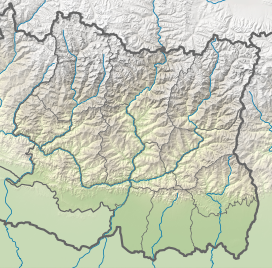| Ama Dablam | |
|---|---|
 Ama Dablam from Chola Valley | |
| Highest point | |
| Elevation | 6,812 m (22,349 ft)[1] |
| Prominence | 1,041 m (3,415 ft)[2] |
| Listing | List of mountains in Nepal |
| Coordinates | 27°51′40″N 86°51′40″E / 27.86111°N 86.86111°E |
| Geography | |
| Location | Khumbu, Nepal |
| Parent range | Khumbu Himal |
| Climbing | |
| First ascent | 1961 |
| Easiest route | Rock/snow/ice climb |
Ama Dablam is a mountain in the eastern Himalayan range of Koshi Province, Nepal. The main peak is 6,812 metres (22,349 ft), the lower western peak is 6,170 metres (20,243 ft). Ama Dablam means "mother's necklace"; the long ridges on each side like the arms of a mother (ama) protecting her child, and the hanging glacier thought of as the dablam, the traditional double-pendant containing pictures of the gods, worn by Sherpa women.[3] For several days, Ama Dablam dominates the eastern sky for anyone trekking to Mount Everest Base Camp. For its soaring ridges and steep faces Ama Dablam is sometimes referred as the "Matterhorn of the Himalayas."[4] The mountain is featured on the one rupee Nepalese banknote.[5]
Although Alfred Gregory led the first attempt on Ama Dablam in 1958[6] it was on 13 March 1961 that the first successful ascent was made, when Mike Gill (NZ), Barry Bishop (US), Mike Ward (UK) and Wally Romanes (NZ) ascended the Southwest Ridge. They were well-acclimatised to altitude, having wintered over at 5,800 metres (19,029 ft) near the base of the peak as part of the 1960–61 Silver Hut expedition, led by Sir Edmund Hillary.[7]
Situated at a distance of 162 km (101 mi) north of the provincial capital of Biratnagar and 152 km (94 mi) northeast to Kathmandu, Ama Dablam is the third most popular Himalayan peak for permitted expeditions. The most popular route by far is the Southwest Ridge (right skyline in the photo).[8] Prior to a 2006 avalanche, climbers typically set up three camps along the ridge with Camp III just below and to the right of the hanging glacier, the Dablam. Any ice that calves off the glacier typically goes left, away from the camp. However, after the avalanche, climbers now prefer to set just two camps to minimize risk. Camp I is at an altitude of over 5,800 metres (19,029 ft), and Camp II is at an altitude of over 6,000 metres (19,685 ft). A climbing permit and a liaison officer are required when attempting Ama Dablam. As with Mount Everest, the best climbing months are April and May (before the monsoon) and September and October.
- ^ Nepa Maps (Pvt. Ltd.), NE517: Everest Base Camp & Gokyo, Kathmandu, Nepal, 2013
- ^ "Ama Dablam". Peakbagger.com. Retrieved 2009-03-01.
- ^ Kennedy 2005, p. 22
- ^ Bo Parfet, Richard Buskin, Die Trying: One Man's Quest to Conquer the Seven Summits, p. 205
- ^ "पैसाले भन्ने रोचक कथा". Himal Khabar. Retrieved 2022-04-07.
- ^ Gregory, Alfred (1959). "Himalaya, Nepal, Ama Dablam". American Alpine Journal. #11 (33). ISSN 0065-6925. Retrieved 15 August 2024.
- ^ Kennedy 2005, p. 26
- ^ Kennedy 2005, p. 27

